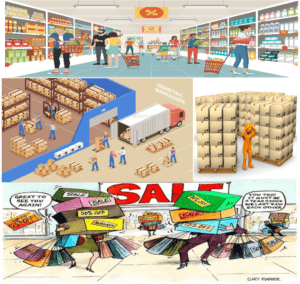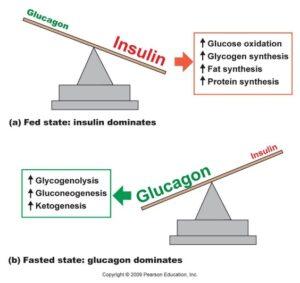Nutritional Metabolism – our body relies on a series of events to actively maintain metabolic energy levels. The primitive nature of our physiology sees only two phases associated with nutritional necessity, Post-Absorptive (Fasting) or Absorptive (Fed). During the Post-Absorptive phase, the body is converting stored energy into useable energy to be consumed. During the Absorptive phase, the body is taking the newly processed nutrients and storing them into the cells in anticipation for the Post-Absorptive phase.
 Similar to a large supermarket (Wal-Mart), deliveries are made daily (eating). The delivered products are unpackaged, itemized, and stocked in the appropriate departments (digestion and storage of glucose, triglycerides, and amino acids). Customers purchase the products and the supply becomes reduced or exhausted (metabolism of energy). If a product does not sell, it remains on the shelf, taking up space for other products. New shelves or storage bins (fat cells) are required to accommodate the excess stock and still allow for new stock to be placed for customers to purchase. Eventually the inventory becomes unmanageable (obesity) and the management decides to place the excessive items on “sale” (going on a diet), with hope that customers purchase all of the excessive items (weight loss and fitness).
Similar to a large supermarket (Wal-Mart), deliveries are made daily (eating). The delivered products are unpackaged, itemized, and stocked in the appropriate departments (digestion and storage of glucose, triglycerides, and amino acids). Customers purchase the products and the supply becomes reduced or exhausted (metabolism of energy). If a product does not sell, it remains on the shelf, taking up space for other products. New shelves or storage bins (fat cells) are required to accommodate the excess stock and still allow for new stock to be placed for customers to purchase. Eventually the inventory becomes unmanageable (obesity) and the management decides to place the excessive items on “sale” (going on a diet), with hope that customers purchase all of the excessive items (weight loss and fitness).
The Role of Insulin in Weight Management – human physiology is basically divided into antagonistic systems (opposing). One system is initiated when a level gets too high and the other is initiated when a level gets too low. Nutrient metabolism is basically associated with the hormones Insulin and Glucagon. Both are produced in the pancreas in response to levels of blood glucose availability.
 When we eat, the food is digested and absorbed into the blood stream for transport to the cells. Insulin is released as a result of elevated blood sugar levels. Insulin travels in the blood to the cells where it opens the “gates” on the cell wall, allowing glucose to be transported into the cells. As the glycemic levels (blood sugar levels) drop, signals to stop insulin production are sent and signals to start glycogen production begins. Glycogen is released as a result of decreased blood sugar levels. Glycogen travels to the liver and muscle cells to trigger their release of stored sugars back into the blood stream. Once the liver and muscle storages are exhausted, glycogen would then begin to release stored “fats” from the fat cells into the blood stream. The “fats” enter the liver and are converted back into glucose (gluconeogenesis). This process continues to reverse itself in response to blood sugar levels.
When we eat, the food is digested and absorbed into the blood stream for transport to the cells. Insulin is released as a result of elevated blood sugar levels. Insulin travels in the blood to the cells where it opens the “gates” on the cell wall, allowing glucose to be transported into the cells. As the glycemic levels (blood sugar levels) drop, signals to stop insulin production are sent and signals to start glycogen production begins. Glycogen is released as a result of decreased blood sugar levels. Glycogen travels to the liver and muscle cells to trigger their release of stored sugars back into the blood stream. Once the liver and muscle storages are exhausted, glycogen would then begin to release stored “fats” from the fat cells into the blood stream. The “fats” enter the liver and are converted back into glucose (gluconeogenesis). This process continues to reverse itself in response to blood sugar levels.

